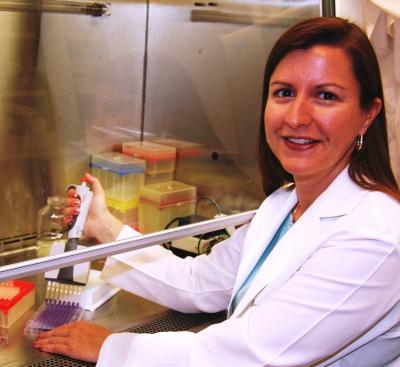"Continuous glucose monitoring is much more effective and accurate than previous glucose monitoring techniques and has revolutionized how veterinarians manage diabetes in dogs," said DeClue. "The CGM gives us a complete view of what is happening in the animal in their natural setting. For example, it can show us if a pet's blood glucose changes when an owner gives treats, when the animal exercises or in response to insulin therapy."
CGMs have become more commonly used in dogs with diabetes that are not responding well to conventional treatment. The monitor provides detailed data for glucose concentrations throughout the course of three days in a dog's usual environment, so veterinarians can make better treatment decisions. Previously, veterinarians would have created an insulin regimen based on a glucose curve by taking blood from the animal in the veterinary hospital every two hours over the course of a single day. The glucose curve was often inaccurate due to increased stress from the animals being in an unnatural environment.

University of Missouri veterinarians have changed the way veterinarians treat diabetes in animals by adapting a device used to monitor glucose in humans.
(Photo Credit: MU News Bureau)
Dogs show clinical signs of diabetes similar to humans. Clinical signs include increased urination, thirst, hunger and weight loss. Typically, no direct cause is found for diabetes in dogs, but genetic disposition and obesity are thought to play a role in causing diabetes, according to DeClue. Just like people, dogs suffering with diabetes must be medically managed or complications can arise.
"Typically, dogs that are treated properly for diabetes go on to live a long, full life," said Wiedmeyer.
"Actually, dogs with diabetes are similar to young children with diabetes but somewhat easier to manage. Dogs will eat what their owners give them at the same time each day and they won't ask for a cupcake at a friend's birthday party. With tools like the continuous glucose monitor to assist with disease management, the outlook is very good for a dog with diabetes."
In the future Wiedmeyer projects that the device will become smaller and less invasive. In addition, he hopes device manufacturers develop a device that would monitor blood sugar levels remotely.
DeClue and Wiedmeyer's most recent article on methods for monitoring and treating diabetes in dogs was published in the journal, Clinic in Laboratory Medicine.

Amy DeClue is an MU assistant professor of veterinary internal medicine.
(Photo Credit: MU News Bureau)

Charles Wiedmeyer is an MU assistant professor of veterinary clinical pathology.
(Photo Credit: MU News Bureau)
Source: University of Missouri-Columbia